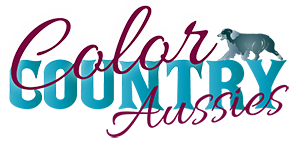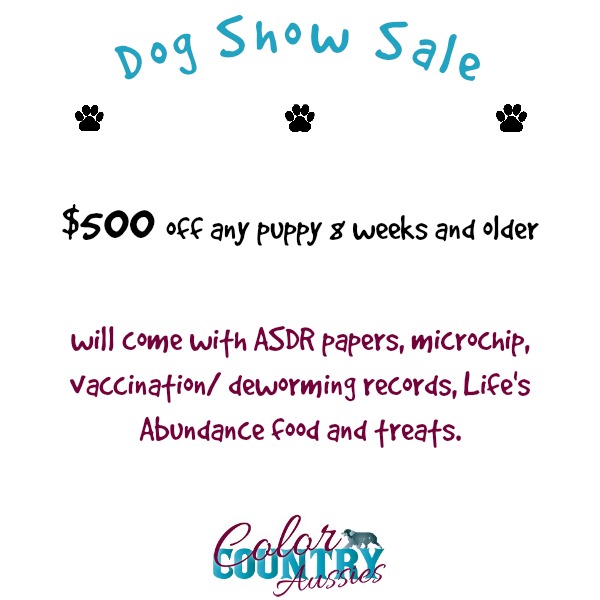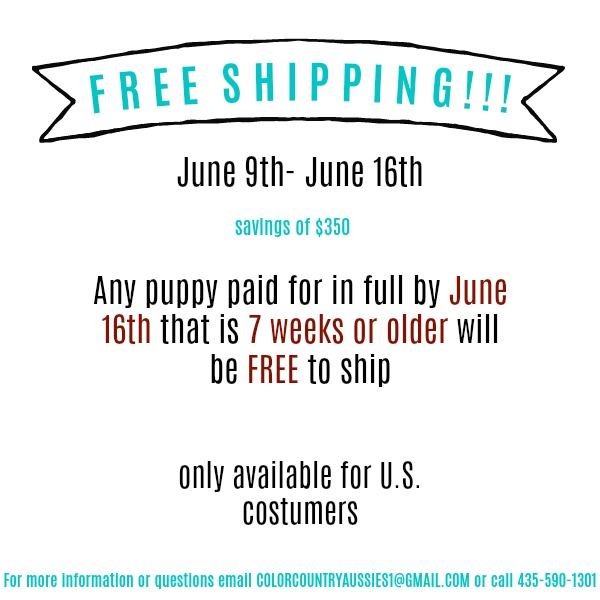About Aussies
Miniature and Toy Australian Shepherd CharacteristicsMiniature Size Description
General Characteristics
The Miniature Australian Shepherd is almost identical in appearance to the standard or full-sized Australian Shepherd in everything but size. The Miniature Australian Shepherd is actually less than 18 inches tall (46 cm) at the withers when full grown, and there is also a smaller version of the breed known as a Toy Australian Shepherd which must be less than 14 inches or (36 cm) when fully grown. A still smaller variety known as the Tea Cup must be less than 12 pounds when fully grown. The Miniature Australian Shepherd is an athletic dog that should appear solid and sturdy without appearing stocky. They have a medium length straight coat that can have a slight wave but never a curl. The coat is double with a somewhat thick and coarse outer coat covering a soft, downy inner coat. The outer coat is not coarse feeling but is rather smooth to the touch. The body is longer than the dog is tall at the shoulders, and the rib cage and chest is moderately developed. The topline is very straight from the withers to the hips. The legs are straight and the feet are slightly arched with the back legs having a well defined stifle that gives the dog its ready to jump into action appearance. The neck is in proportion to the body and flows naturally into the shoulders. The head is carried high and level when walking but often carried lower when working livestock. The muzzle is tapered and there is a well-defined stop between the muzzle and the eyes. The eyes may be different colors including blue, brown, amber and flecked, but are always slightly almond shaped and very clear and alert looking. The ears are carried high on the head and are full triangles with slightly rounded tips. The top one quarter to one-half of the ear should fold forward and ears with no fold or ears that don’t stay erect are considered faults in show dogs. The legs and lower body are covered with slightly longer hair known as furnishings. The Miniature Australian Shepherds are either born with a very short, stubby tail known as a natural bobtail or the tail is docked when they are a few days old. In some countries docking is prohibited so the dogs may be seen with natural tails that are still shorter than other Collie breeds.
Coat Description
The double coat is of medium length and is very thick and full without giving the appearance of being fluffy. The hair is longer on the ruff, legs and rump and may be slightly wavy, but never curly or kinky.
History
The Miniature Australian Shepherd is not a cross between an Australian Shepherd and another breed. It was actually developed in the late 1960’s and mid 1970’s by breeding the smallest of the Australian Shepherds. This constant breeding back to the smallest of the litters produced a consistently small breed that is even being further reduced in size to the toy variety. Although the Australian Shepherd originated in Australia as a herding and working dog, the Miniature Australian Shepherd was bred first in the United States. This was largely in response to the dog owners’ desire for a well-behaved, herding type dog with the coat variations found in the Miniature Australian Shepherd that would be more suited to smaller living spaces and yards in cities. In many areas the Miniature Australian Shepherd is still used as a working breed in competitions, and many people feel that the term miniature is a bit misleading as the smaller dogs are only miniature in size to the standard, and are not petite and tiny like other “miniature” breeds.
Temperament
Just like the standard Australian Shepherd, the Miniature Australian Shepherd is a working dog. They are typically a very easy going dog that loves to be with people and all types of animals, although they will naturally try to herd almost anything they see including children, people and other pets. Usually the breed is not dog aggressive at all and will stay in a house very comfortably with cats and even smaller pets, although socialization is important with any dog and other types of pets. The Miniature Australian Shepherd is a great companion dog for other breeds of dogs, even those that tend to be somewhat dominant. The Miniature Australian Shepherd is a good watchdog and will bark whenever someone unknown approaches. They are not yappy like some of the miniature breeds and can easily and quickly be taught not to bark or to stop barking on command. One of the differences in the Miniature Australian Shepherd and other herding or working dogs is that it is quiet when herding and does not yap or bark at the animals.
Overall the Miniature Australian Shepherd is a wonderful dog with children of all ages. They are very active dogs requiring lots of daily exercise, and they will run and play with children as long as the kids are busy. While a smaller dog, they are not delicate and can handle romping and average types of play with kids of all ages. Since they are very compliant dogs and love to please the family they will listen to children and respond to commands from even the youngest kids. The Miniature Australian Shepherd loves to be with the family and is not recommended for families where it will be left alone for long periods of time. They are very well behaved dogs in the house and will quickly find a quiet, out of the way spot to watch the family. They also love to play and be the center of attention when everyone is busy in the house.
Training the Miniature Australian Shepherd is very easy and they can learn to do amazingly complex tricks with ease. They also love to be the center of attention and are naturally very playful and almost puppy-like in their behavior right up until they are very senior dogs. They are very affectionate with family members and seem to need to be physically close to the family without being demanding of attention. Since the breed is a working dog they do need to have something to do every day, even if it is just go for a walk and go through a training routine. When not challenged or stimulated mentally, they will turn their energy and natural curiosity into more destructive behaviors such as chewing and finding out how to get into cupboards and other areas of the house. With attention, lots of exercise and proper training and stimulation, this is very rarely an issue with the breed.
Miniature Australian Shepherds enjoy traveling and going new places. They are somewhat wary of new people and will often skirt around the edges of gatherings until they feel comfortable with the people. Socialization will help minimize this behavior, but it is important to never force the dog to interact as this can lead to distrust and fear of strangers or even of family members.
Grooming
The Miniature Australian Shepherd has an easy to care for coat that is not as problematic as some of the double coated breeds. The thicker, slightly coarse and straight outer coat is simple to brush using a pin brush or stiff bristle brush. Always start by grooming the outer coat in the direction of growth which is slightly back and down. After this is completed, start at the shoulders and push the longer hair forward, exposing the dense, downy undercoat, brush this again the direction of growth, moving down the back and sides. Pay particular attention to the hair round the neck, the furnishings on the legs and the hair on the rump as these can be areas for matting and tangling.
Typically the Miniature Australian Shepherd is an average shedder; however, they will shed their coats heavily in the spring and fall. During these times the inner coat will come out in chunks or clumps and can become very matted. Daily brushing will both help speed up the shedding as well as prevent these mats from forming. If mats do form in the hair that is being shed, they may need to be cut out using blunt-ended scissors.
The Miniature Australian Shepherd should not be clipped or trimmed for show and typically should not require any type of clipping or trimming. Puppies have shorter coats that will not reach their full adult coat length until about a year of age. The Miniature Australian Shepherd has natural oils in the hair to keep the dog dry and warm even in cold or damp conditions so it is not advisable to bathe this breed unless absolutely necessary. Dry dog powder is often used between wet baths just to help remove dirt from the hair.
Exercise
This breed is ideal for an active family that loves to walk, hike, run and play. These small dogs need a large amount of both physical and mental exercise to stay alert and well behaved in all conditions. A Miniature Australian Shepherd is considered a high exercise breed but doesn’t need to be busy all the time as long as the exercise is regular and long enough in duration and challenge. Just taking these dogs for a walk is not likely to give them the stimulation that they need to get a mental workout, but having them work through an obstacle course, taking them on new routes where they are seeing and smelling new things as well as having them work through some training exercises will usually provide the right balance of physical and mental work. The Miniature Australian Shepherd is an ideal dog for obedience, agility and herding trials. Many people trial their Miniature Australian Shepherds in one of these events and take them to various events in their local communities or even in larger, more national competitions and events. These wonderfully behaved and very social dogs make ideal event dogs as they rarely fight or show any signs of dog aggression.
Training
The Miniature Australian Shepherd is really a treat to train. They are one of the easiest dogs to house train and are extremely neat and clean. Even as puppies they naturally stay beside their owners and quickly learn what pleases the family. The very best possible training for these dogs is positive rewards in the form of verbal praise and petting. They will work as hard as they can to keep people in the family happy and love to be given commands and tasks to do. They also love to think and solve problems and are great at games of hide and seek with favorite toys. The breed has an amazing ability for word recognition and therefore can be easily taught a huge number of tricks and training exercises. They excel at agility, obedience and trial type competitions including herding. The breed does need socialization in their training to avoid being somewhat nervous of new people or places. A Miniature Australian Shepherd should never be treated harshly or spoken to in a rough tone of voice as they can become timid and cowed if treated poorly. The Miniature Australian Shepherd is very loyal to their family and will bond very quickly with all people in their house. They often do not do well if re-homed or left with people they don’t know. If you do have to leave your Miniature Australian Shepherd with someone else, be sure to introduce the dog and the family first and allow the dog to get to know them to help with the transition.
Toy Size Description
General Characteristics
The Toy Australian Shepherd originated within the United States. It stands 10-14 inches and weighs between 12-17 pounds.
Coat
The coat on the Toy Australian Shepherd is medium-length and slightly wavy, though it can be straight. There should be feathering of the hair on the back of the legs.
Character
The Toy Australian Shepherd is an intelligent breed. It is primarily a working dog of strong herding and guardian instincts. This breed is an excellent companion and is versatile and easily trained, performing their assigned tasks with great style and enthusiasm. The Toy Australian Shepherd is reserved with strangers, but does not exhibit shyness.
Temperament
The Toy Australian Shepherd is an excellent companion for children. They act as a devoted friend and guardian. Toy Australian Shepherds are easy going, loyal and courageous. The Miniature Australian Shepherd can become nervous and destructive without frequent socialization and proper exercise. They are working dogs and want a job to do.
Care
The Toy Australian Shepherd needs little grooming and are an average shedder. Brush occasionally with a firm bristled brush and bathe only when needed.
Training
The Toy Australian Shepherd is easily trained. They seem to have a sixth sense to know what their owner wants and they are very eager to please. The Toy Australian Shepherd does need training at an early age to avoid nipping at the heels of humans as they are a herding dog by instinct and will try to herd their humans.
Activity
The Toy Australian Shepherd needs daily, vigorous exercise. They enjoy long walks and playtime as they are an energetic breed. They do best when they have a job to do.
Breed Size Reference Chart
| Teacup Weight | Under 12 pounds | 5.5 kg |
| Toy Height | 10-14 inches | 26-36 cm |
| Toy Weight | 12-17 pounds | 5.5-8 kg |
| Miniature Height | 13-18 inches | 33-46 cm |
| Miniature Weight | 20-40 pounds | 9-18 kg |
Obedience
Colors
Tails
People often ask, “Why is the Australian Shepherd’s tail docked?” Some of the reasons are tradition, identification, cosmetic and function. Tail docking has most likely occurred since ancient times. It has been written that the Romans docked tails because they believed, erroneously, that the muscles in the dog’s tail were a cause of rabies. In the late 1790’s, a tax law was introduced on dogs to help fund the French wars. Working dogs were the exemption and were docked to signify their status. This practice was also in place in Great Britain.
Woods Natural History, published in London in 1865, lends insight into the historical practice of tail docking. “The tail of the sheep dog is naturally long and bushy, but is generally removed in early youth on account of the now obsolete laws, which refused to acknowledge any dog as a sheep dog or to exempt it from tax, unless it were deprived of its tail. This law, however, often defeated its own objective, for many persons who liked the sport of coursing and cared little for appearances, used to cut off the tails of their greyhounds and evade the tax by describing them as sheep dogs.” Another reason is as dogs assisted man in the field, herding or hunting, their tails were a magnet for foxtails and a host of other burrs and stickers, which could cause trauma to the tail.
Consequently, tail docking was implemented to avoid injury and infection. This is one of the reasons natural bobtails were valued and bred for. As dog shows became fashionable in the mid 1800’s with the establishment of the Kennel Club, tails of some breeds were docked as an identifying characteristic. Even today, in breeds with congenital bobtails, the tail is sometimes shortened to enhance a more symmetrical appearance, or to avoid drawing the eye away from desired colors and also creating a classic silhouette for the showing. Why is the Aussie’s tail docked? The clearest answer I can give is that it is probably tradition and that it is stated in the breed standard that, “An identifying characteristic is the natural or docked bobtail.”
We do offer you the option to purchase a dog with a tail of you prefer. Please call us at 435-590-1301 to find out how to keep your puppy’s tail.














